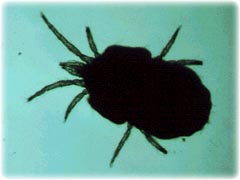Snake Mite Infestation
Also known as: Ophionyssus natricis infestation
Introduction
The snake mite (Ophionyssus natricis) is a common and significant ectoparasite of captive snakes. The feeding of the mites causes irritation and clinical disease. They are suspected of being a mechanical vector for ophidian paramyxovirus and inclusion body disease. Snake mites will also feed on other animals including humans but may not complete their life cycle when infecting alternative hosts. They require a blood meal before they are able to reproduce.
Clinical Signs
The owner may note black parasites in the snake's water bowl, a white powder on the skin (the mite moulds and faeces) and long periods of soaking. Visual inspection of the skin may reveal mites (the engorged female is the most obvious stage - see Snake Mites). The most common sites for mites are the gular and periocular regions, labial pits and commissures of the mouth. On the body, the ventrolateral aspect (scale rows one and two) is often colonised. Skin lesions range from very mild to severe. Mite feeding is irritating to the host and causes oedema and erythema. Clinical signs include dysecdysis often with retained spectacles, anorexia, weight loss and lethargy. Very heavy infestations may result in anaemia, dehydration and death.
Diagnosis
Diagnosis is suspected from history and physical examination. Microscopical identification of the mite is the definitive diagnosis. Biopsy and histopathology of skin lesions may be performed.
Treatment
Acariasis is highly contagious and can be very difficult to eliminate. There are various treatments but all must treat the environment as well as the host. Insecticides that have been advised include pyrethrins and pyrethroids, organophosphates and ivermectin. More recent treatments include the use of chitin disregulators such as lufenuron.
Treatment must be directed at the environment as well as the host and protocols should continue for at least six weeks. Environmental treatment must include the cage and all areas and objects within the room. All crevices and corners need to be treated as snake mites prefer darkness. Discard any cage objects that cannot be thoroughly cleaned. The substrate should be replaced twice a week during the parasitic treatment. Sprays can be used in the environment and on the animal.
- Water - Steam cleaning of the environment is extremely useful since all stages of mites are susceptible to both drowning and high temperatures. Infested snakes find some relief by soaking themselves. Water can therefore be used as a non-toxic adjunct treatment. Affected snakes, especially those that are severely compromised, can benefit from daily soaks of at least one hour.
- Desiccants - Mites are very susceptible to desiccation but their use may not help in their eradication. Mites travel up cage walls rather than staying in the substrate so they may not come into contact with the desiccant. Silica gel desiccants may detrimentally affect smaller snakes and could be carcinogenic in humans.
- Insecticides
- Organophosphates (OPs), including trichlorphon and dichlorvos, have been recommended for treating snake mite infestation. However, due to the possible toxicity for both humans and reptiles the use of these products should be discouraged.
- Pyrethrins and pyrethroids have been used on the snake as well as the environment. Permethrin is a commonly available pyrethroid and can be made into a solution for spraying at 10 day intervals.
- Ivermectin is an effective acaricide by oral, parenteral or topical administration.
- Fipronil is an effective topical acaricide that may last several months with one application. The environment may also be treated. It appears to be safe and effective.
- Insect growth regulators - Lufenuron inhibits chitin synthesis and appears to be very safe and effective. For long-term treatment in most situations lufenuron is the treatment of choice.
The best way to apply acaricidal sprays is to spray a cloth with the product, and then allow the snake to move through the cloth as this spreads the treatment all over the skin.
Prevention
Acariasis is usually associated with poor hygiene or lack of quarantine for recent imports. Unfed mites can survive for prolonged periods of time under favourable environmental conditions so attention to hygiene is important. Regular cleaning, preferably steam cleaning, of the environment is a must. New reptiles should be quarantined and prophylactic treatments carried out.
Prevention includes monitoring snake behaviour, close examination of the bottom and the water surface of water bowls. Also owners should check their own hands after handling the snake. Species that require humid surroundings (e.g., many tropical boids) are at high risk of mite infestation.
| Snake Mite Infestation Learning Resources | |
|---|---|
 Test your knowledge using flashcard type questions |
Reptiles and Amphibians Q&A 01 |
 Search for recent publications via CAB Abstract (CABI log in required) |
Snake Mite publications |
 Full text articles available from CAB Abstract (CABI log in required) |
Reptile ectoparasites - how to kill those little buggers. Greek, T.; The North American Veterinary Conference, Gainesville, USA, Small animal and exotics. Proceedings of the North American Veterinary Conference, Orlando, Florida, USA, 16-20 January 2010, 2010, pp 1676-1677 - Full Text Article |
References
Frye, FL & Williams, DL (1995) Self-Assessment Colour Review - Reptiles & Amphibians Manson
| This article has been peer reviewed but is awaiting expert review. If you would like to help with this, please see more information about expert reviewing. |
Error in widget FBRecommend: unable to write file /var/www/wikivet.net/extensions/Widgets/compiled_templates/wrt69635f0788aef2_49622024 Error in widget google+: unable to write file /var/www/wikivet.net/extensions/Widgets/compiled_templates/wrt69635f078ed412_02874723 Error in widget TwitterTweet: unable to write file /var/www/wikivet.net/extensions/Widgets/compiled_templates/wrt69635f0793a0d8_62839311
|
| WikiVet® Introduction - Help WikiVet - Report a Problem |
